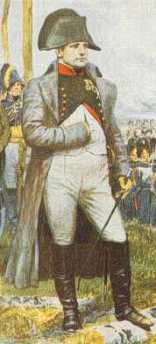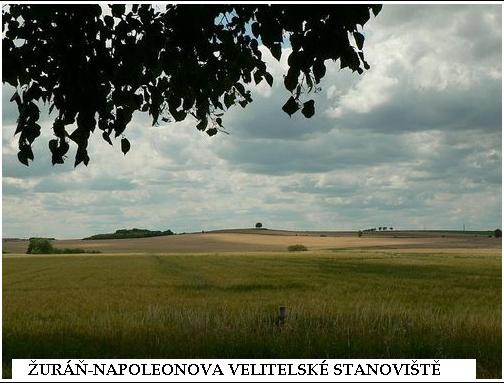blbossssssssssssssssssssssssssssssssssst!!!!!!!!!
Battle of the Three Emperors No.1
Categories: Years of war and revolution
BATTLE OF THE THREE EMPERORS
(vol. 1)
Two emperors to Olomouc, the third to Brno
The Russian troops began to move through Moravia as early as September, and continued to move with small interruptions until the Battle of Slavkov. The inhabitants of the Brno, Znojmo and even Hradiště regions were not only burdened by the obligatory food supplies, but also by the obligation to provide the passing troops with shelter. The infantry were transported by ten on peasant carts, while the officers rode in carriages supplied by the nobility, estate officials, church dignitaries, millers and townspeople. The cavalry and artillery also needed many horses. Peasants therefore fled the areas intended for supplies and took their cattle to the forests.  Among the difficulties associated with the preparations for the decisive battle was the poor organisation of supplies provided by the Austrian authorities. In Moravia, they were managed by a provincial commissariat headed by the governor of the Brno region, Wolfgang of Manner. His task was not easy. He did not have comprehensive information about the state of the warehouses or the needs of the troops, whose numbers were constantly increasing. Nor did he enjoy sufficient respect from the military authorities, who did not respect his orders very much and often collected food on their own. Nor did the commissariat win the confidence of the frightened civilian population.
Among the difficulties associated with the preparations for the decisive battle was the poor organisation of supplies provided by the Austrian authorities. In Moravia, they were managed by a provincial commissariat headed by the governor of the Brno region, Wolfgang of Manner. His task was not easy. He did not have comprehensive information about the state of the warehouses or the needs of the troops, whose numbers were constantly increasing. Nor did he enjoy sufficient respect from the military authorities, who did not respect his orders very much and often collected food on their own. Nor did the commissariat win the confidence of the frightened civilian population.
Even after Kutuz's retreat to Brano in Moravia, the Russian-Austrian relationship did not improve much. The troops retreated through Znojmo, Pohořelice, Rajhrad, Židlochovice, Měnín and Šlapanice to Vyškov, where they stopped briefly. After clearing Brno, they all retreated together to the fortified camp at Olšany near Olomouc, where they arrived on 22 November. The Olšany camp, strategically located between the Morava River and the then inaccessible forests of the Drahan Highlands, with its rear covered by the Olomouc fortress, was the place where all Russian troops were concentrated. The Russian Tsar Alexander and the Austrian Emperor Franz were accommodated in Olomouc.
The masked rush
Meanwhile in Vienna, Napoleon knew he had to act quickly. His troops were on the march all the way from Bolougne and were running out of strength. The constant taking of new areas and the extensive securing of the flanks of the army was weakening them greatly. The Emperor was well aware that a decisive encounter must take place as soon as possible. He could rely on the boundless confidence of his soldiers, but otherwise the situation was not favourable for him. Kutuzov had received fresh reinforcements from Russia and had an army of seventy-five thousand. From the south, help was coming to the Allies in the form of the ninety-thousand strong army of Archdukes Charles and John. Beyond the Ore Mountains, the Prussian army was ready. So there was reason to hurry. But French tactics of deception suggested the opposite.
The French followed the Russian troops into Moravia. After a minor skirmish at Vojkovice nad Svratkou , they captured Brno on November 19, a welcome stop for the emperor. On that day Prince Murat, at the head of two cuirassier regiments, stormed through the Brno gate into the city, and by evening over 30,000 Frenchmen were stationed there. At the deserted Špilberk, Napoleon's soldiers captured cannons, a large number of rifles and a considerable supply of gunpowder. They were often led to the secret ammunition caches by local people.
According to various records, Napoleon's troops were iron disciplined, but they exacted the prescribed supplies from the inhabitants ruthlessly. In some Brno districts, people had to move out of their ground-floor flats and prepare places to stable their horses. Cattle were taken from nearby settlements and yards and slaughtered by the French right in the town square.
Until the end of November, there were daily parades. Napoleon mentally prepared his soldiers for the great battle.
There would be a battlefield.........
In Brno, the French were finally able to get some rest after a long time. But on Thursday, November 21, eight days after his triumphant entry into Vienna, Napoleon and his marshals left to explore the countryside east of Brno. He carefully advises the commanders, "Take a good look at this terrain. It will be a battlefield...... you will have to play your part here."

From the top of Žuráň there is a good view of the countryside where the villages of Jiříkovice, Práce, Blažovice, Ponětovice and Telnice lie. The town of Slavkov is more than ten kilometres to the east.
PLANNED ASSASSINATION
At the Brno Gate lived the journeyman Kristl. He came from Bouzov and was employed in Brno by the master compiler Mitternaier. He belonged to the people who considered Napoleon a "cursed man", bringing war and misfortune to our country. So he decided to wait for the dreaded dictator with a rifle. He confided his plan to the master. He showed him the place at the gate where he would lie in wait for the Emperor and the way he would escape after the deed. It was to take place as Napoleon was driving through the Brno Gate on 29 November to Špilberk Castle to inspect the fortifications.
It is not known what happened afterwards, whether Master Mittermaier talked his companion out of his intention, or whether Kristl changed his mind himself. What is certain is that he talked a lot about his "plan", but never decided to go through with it. So Napoleon remained alive and well until the decisive battle.
HOW RECRUITING WAS DONE
Motto:No regard for women, no regard for children,Who'll feed it all over our land!
The Bohemian and Moravian boys were not too keen to fight for their lord emperor, even at a time when a woman sat on the Austrian throne. In 1753, Maria Theresa introduced a periodic census, which was to be the basis for obtaining an inventory of men fit for arms, to determine the number of recruits to replenish the army. From 1771 this census was called a conscription, i.e. registration or enrolment of recruits.
The very next year, recruiting districts were established, which had a specified number of compulsory enlistments for each year. Conscription applied to a number of socially privileged persons, but in the villages only to independent peasants and their eldest sons as principal heirs. Military service was the bane of the rural population because it was usually for life, although from 1802 soldiers were conscripted for 'only' ten to fourteen years.
Continued next time...........
You can search for artefacts from this period using our metal detectors.
The article is included in categories:


